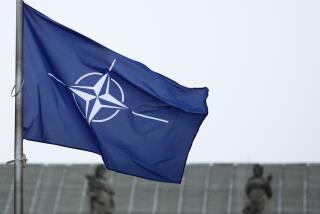Munitions Blamed for ‘Balkan Syndrome’
PARIS — Americans have heard much about Gulf War syndrome, the still-mysterious complex of diseases and health problems that thousands of veterans believe they contracted during Operation Desert Storm. Now, is a Balkan syndrome emerging as well?
Specifically under suspicion are the depleted-uranium munitions used by U.S. A-10 Warthog warplanes as armor-piercing rounds. During the 11-week Kosovo air campaign in 1999, U.S. pilots fired more than 30,000 of the superdense slugs at Serbian tanks--leaving an estimated 10 tons of depleted uranium littering the landscape. And that doesn’t include the 10,000-plus rounds fired by NATO-led forces in neighboring Bosnia-Herzegovina during its earlier war.
After the death from leukemia of a sixth Italian soldier who served with North Atlantic Treaty Organization peacekeeping forces in the former Yugoslav federation was made public this week--bringing the total European deaths to 16--the Italian government demanded a full accounting from the U.S.-led alliance.
“Let NATO tell the truth!” Italian Prime Minister Giuliano Amato demanded.
In Belgium, according to news accounts, nine Balkans veterans have been diagnosed with leukemia, and five of them have died. Two former peacekeepers each in Spain and Portugal reportedly have succumbed to the blood cancer, as has a Czech military pilot.
France on Thursday announced that four of its former Balkans peacekeepers were under treatment in military hospitals for leukemia and, through Defense Minister Alain Richard, called on the Clinton administration to be “open” about any and all health risks connected to the depleted-uranium shells.
Depleted uranium reportedly is the heaviest metal known--1.7 times heavier than lead--which gives it enormous punch when shot at high velocity from a cannon.
The 2.2-pound shell fired by the A-10 is only mildly radioactive in its natural state, but on impact with a solid object such as a tank, the metal turns into a searingly hot dust as fine as baby powder.
Troops working in an area where atomized uranium is present--for example, the hulk of a knocked-out tank--are supposed to wear masks to prevent them from inhaling the particles, Pentagon spokesman Kenneth H. Bacon said Thursday.
Washington insists that no scientifically proven “direct link” exists between cancer in humans and depleted uranium--which Bacon said is 40% less radioactive than uranium ore found in nature. And he said regular health checks have revealed no symptoms of leukemia and other illnesses among U.S. troops who served in the Balkans.
But such assurances have done little to calm Europeans’ jitters.
In a radio interview, the sister of one of the dead Italian soldiers, Salvatore Carbonaro, accused her country’s military of conducting a cover-up. Lella Carbonaro said she was “certain” that one of “Salvatore’s superiors is partly responsible for his death, and they [the military] would be more comfortable if the truth does not come out.”
Salvatore Carbonaro, 24, who served two tours in Bosnia’s capital, Sarajevo, in 1998-99, died Nov. 6 at a military hospital in Pavia. In a diary he kept until his death, which was quoted posthumously in the media, the young Sicilian chronicled his agony and puzzlement.
“I want to know why I’m dying,” Carbonaro wrote. “It’s the benzene with which I cleaned weapons, I’m sure of it. They, my superiors, knew it was a dangerous substance, that I should have had gloves and a mask to use it, and they told me nothing, and now I’m dying.”
Increasingly worried about health risks that their nationals might have been exposed to, Spain, Portugal, Finland, Belgium, Greece, Bulgaria, the Czech Republic and Turkey have announced radiation screening programs for former Balkans peacekeepers. In Portugal alone, that means testing 10,000 soldiers and civilians.
Robert Haley, an epidemiologist at the University of Texas Southwest Medical Center who researches Gulf War syndrome, accused European governments of planning the screenings for political reasons.
“Everybody has learned from the Gulf War and what happened with the veterans and the accusations of a cover-up. They’ve learned that you better take it seriously and act early,” Haley, who says he doubts that there is enough radiation in depleted uranium to cause radiation-related diseases, told the Associated Press.
The North Atlantic Council, NATO’s permanent steering body, will take up the controversy at its meeting Wednesday in Brussels. Spokesman Mark Laity said the alliance was already conducting its own inquiry, and he asserted that everything possible will be done to give the Italians the information they seek.
“We’re placing a 100% priority on it,” Laity said. “We are committed to being absolutely as open as we can be.”
According to the Pentagon’s Bacon, NATO’s military command estimates that 10,800 armor-piercing rounds were fired by tank-busting A-10s at Bosnian Serb armor around Sarajevo in 1994-95.
NATO Secretary-General George Robertson said last year that about 31,000 of the shells were used during the Kosovo air war, but Yugoslav authorities have accused NATO of using much more depleted uranium in Operation Allied Force. Last year, a deputy defense minister claimed that 50,000 rounds were fired by NATO planes, and he said some areas of the country had to be sealed off because radioactivity had exceeded safe levels.
At a news briefing in Washington on Thursday, Bacon said: “We have studied depleted uranium at considerable length over the years because of assertions it might contribute to Gulf War illness. We have not found any link between illnesses and exposure to depleted uranium.”
The U.S. European Command in Stuttgart, Germany, said Friday that more than 50,000 American troops had been cycled in and out of the Balkans since the autumn of 1995, as well as thousands of civilians acting in support roles.
Asked if the United States would consider a halt to the use of depleted-uranium munitions, which are also used in antitank rounds carried by the Abrams main battle tank, Bacon said, “We don’t see any reasons to consider a moratorium at this stage.”
He downplayed the health risks, but a former U.S. Army colonel who is now a professor of medicine said the threat is very real.
According to the British Broadcasting Corp.’s Web site, https://news.bbc.co.uk, Asaf Durakovic reported last year that he had detected a “significant presence” of depleted uranium in two-thirds of the 17 Persian Gulf War veterans he had examined.
“Some of those particles were inhaled, and if they were too big to be absorbed, they stayed in the lungs, and there they can present a risk of cancer,” Durakovic was quoted as saying.
Pekka Haavisto, a Finn who heads a team from the U.N. Environment Program that is trying to assess the impact of depleted-uranium munitions on the people and environment of Kosovo, also called the vaporized metal a health menace.
“Everybody agrees that inhaling alpha radiation can be dangerous,” Haavisto said in a telephone interview. “The dust remains two hours after the attack. Then it settles step by step to the ground.”
If a Balkan syndrome does exist, its cause or causes might never be established with certainty, as has been the case with Gulf War syndrome. From Western Europe to the United States, some veterans of the allied campaign against Iraqi leader Saddam Hussein’s army nearly 10 years ago blame exposure to depleted uranium for a host of ills, from cancers and chronic fatigue to birth defects in their children. The Iraqi government has made similar claims about its civilians.
But millions of dollars’ worth of studies have been unable to pinpoint whether uranium, Iraqi nerve gas or germ weapons, battlefield stress, pollution from burning oil wells set ablaze by the retreating Iraqis or some other factor is the cause, or indeed whether there is a Gulf War syndrome at all.
According to Bacon, “The lesson of the Gulf War illness studies is that you never exhaust the need for studies.”
*
Times staff writer Paul Richter in Washington and Maria De Cristofaro of The Times’ Rome Bureau contributed to this report.
(BEGIN TEXT OF INFOBOX / INFOGRAPHIC)
Inside the Shells
What Depleted Uranium Is
It is a byproduct of the processing of mined uranium ore. The most radioactive isotopes of uranium are extracted for use in nuclear weapons and civilian reactors. Left behind is the less radioactive isotope 238: depleted uranium.
Why It Is Used
Weapons scientists began in the 1970s to incorporate depleted uranium into the casings and tips of conventional, nonnuclear missiles, shells and bullets. Its great density adds penetrative power to munitions used against tanks or other armored vehicles, and it can burn on impact. Use of depleted uranium in armor plating increases its strength.
Who Has the Weapons
The U.S. military, several other NATO countries and Russia are known to possess depleted-uranium weapons, while Israel, some Arab states and some Asian armies are assumed to have them.
Where They Have Been Used
Never used in warfare before the 1990s, depleted-uranium munitions are known to have been fired only by Western forces. By far their greatest use was during the 1991 Persian Gulf War. Declassified U.S. documents show that American forces fired about 944,000 cigar-size rounds in Iraq and Kuwait.
The Pentagon, under pressure from critics who accused it of covering up the issue, said last year that NATO-led forces fired many fewer--31,000--rounds against Serbian armored vehicles in the 1999 Kosovo conflict. About 10,800 were fired in neighboring Bosnia-Herzegovina in 1994-95, NATO officials reported last month.
U.S. forces also have been accused of firing depleted-uranium munitions during training exercises in other parts of the world.
The Allegations
* The scale of the threat posed by depleted uranium is hotly disputed. But experts agree that the toxic and radiological hazard is heightened by the tendency of depleted uranium to be pulverized on impact into a fine radioactive and toxic dust that stays in the environment, or the body, for many years.
* Iraqi authorities blame thousands of civilian cancer deaths and deformities in babies on contamination by Western depleted-uranium weapons. Critics counter that the casualties might in fact be victims of Iraq’s own chemical arms.
* U.S. veterans groups say depleted-uranium weapons are partly to blame for a vast range of health problems among thousands of veterans who fought in the Gulf War. A Pentagon report last month called such a link “unlikely.”
* A U.N. report last May warned that much of Kosovo’s water could be so contaminated that it is unfit to drink, and that a cleanup of the Serbian province could cost billions of dollars. It warned U.N. staff in the province not to approach any target that might have been hit by a depleted-uranium weapon.
* Italy has demanded that NATO investigate allegations that the deaths of six of its soldiers from leukemia after tours of duty in Kosovo and Bosnia--the so-called Balkan syndrome--may be linked to depleted-uranium weapons.
* Belgium, five of whose soldiers are alleged to have died of suspicious illnesses after Balkans duty, and Portugal, with two alleged victims, joined the Italian appeal.
Source: Reuters
More to Read
Sign up for Essential California
The most important California stories and recommendations in your inbox every morning.
You may occasionally receive promotional content from the Los Angeles Times.










